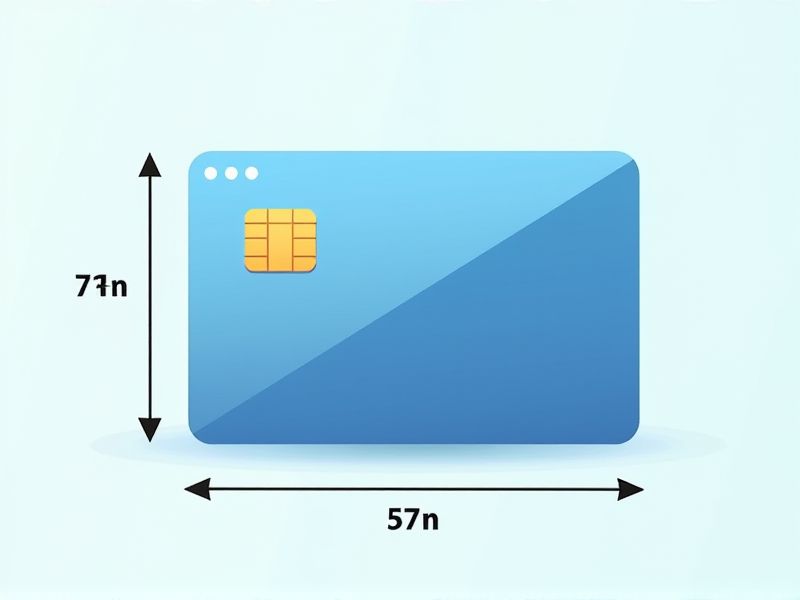
Knowing the standard dimensions of a credit card can help ensure compatibility with wallets, card readers, and payment systems worldwide. A typical credit card measures 85.60 millimeters in width and 53.98 millimeters in height, which is approximately 3.37 inches by 2.13 inches. The standard thickness of a credit card is about 0.76 millimeters or 0.03 inches. These measurements comply with the ISO/IEC 7810 ID-1 standard, ensuring that credit cards can be reliably used anywhere they are accepted.
Size: 85.60 Mm X 53.98 Mm
The standard size of a credit card is 85.60 mm in length and 53.98 mm in width, enabling it to fit easily into wallets and convenient holders. This size adheres to the ISO/IEC 7810 ID-1 format, which is recognized globally for identification and payment cards. You can expect most credit cards, regardless of the issuer, to conform to these dimensions, ensuring compatibility with ATMs and point-of-sale terminals. The thickness of a standard credit card generally ranges from 0.76 mm, providing a sturdy and durable design for everyday use.
Thickness: 0.76 Mm
The standard thickness of a credit card is 0.76 mm, which is designed to provide durability and flexibility for everyday use. This specific measurement ensures compatibility with various card readers and payment terminals globally. With a thickness of just 0.76 mm, your credit card fits seamlessly in wallets, purses, and cardholders, making it convenient for transport. The uniform thickness also contributes to the card's integrity, preventing bending or damage during normal handling.
Shape: Rounded Corners
A standard credit card typically features rounded corners with a radius of approximately 1/8 inch (3.18 mm). This design is not only aesthetically pleasing but also enhances functionality, reducing the risk of card-related damage. The rounded corners facilitate smooth insertion and removal from wallets or cardholders, ensuring your card remains intact over time. By adhering to these specific dimensions, credit cards can easily fit into standard payment processing equipment without causing jams or misreads.
Material: Pvc Plastic Commonly
Most credit cards, including those issued by major financial institutions, are primarily made from PVC (polyvinyl chloride) plastic due to its durability and flexibility. The standard credit card dimensions are 85.60 mm in length and 53.98 mm in width, making them easy to carry and fit into wallets. PVC offers a lifespan of approximately three to five years, depending on usage, and can withstand bending and environmental stresses. This material not only provides security features like holograms and magnetic strips but also allows for vibrant printing of designs and cardholder information.
Iso/Iec 7810 Id-1 Standard
The ISO/IEC 7810 ID-1 standard specifies the physical dimensions and characteristics of credit cards, defining a size of 85.60 mm by 53.98 mm. This format ensures compatibility with card readers and ATMs worldwide, facilitating global transactions. The standard also dictates the card's thickness, which is typically around 0.76 mm, ensuring durability and a minimum bending resistance. Compliance with ISO/IEC 7810 is essential for financial institutions, as it affects the usability and acceptance of credit cards across various payment systems.
Magstripe Alignment
The standard credit card, primarily governed by ISO/IEC 7810 specifications, features a magstripe that aligns with the back edge of the card. This magstripe is 0.76 mm thick and typically spans 12.7 mm in height, encoding vital account information in three separate tracks. Understanding the precise positioning of the magstripe is crucial for ensuring compatibility with card readers, facilitating smooth transactions across various payment platforms. You should verify your card's magstripe orientation to prevent errors during checkout, as improper alignment can lead to reading failures.
Chip Position
The position of the chip on a credit card is standardized to enhance security and ease of use, typically located on the front left side. This EMV (Europay, MasterCard, and Visa) chip technology reduces fraudulent activities by generating a unique transaction code for each purchase. According to recent studies, cards with chips have reported a 76% decrease in counterfeit fraud in the U.S. since their adoption. Ensuring that your card's chip is intact and properly positioned can significantly increase your overall payment security.
Embossing Option
The embossing option on credit cards improves overall security and customer experience by featuring raised characters that can be felt by touch. This tactile element is critical for traditional magnetic stripe readers and ensures compatibility with older payment systems still in use. Over 70% of consumers report they prefer cards with embossed details, associating them with higher security and exclusivity. By choosing an embossed credit card, you enhance not just the aesthetic appeal but also the ease of transaction at various points of sale.
Signature Panel Area
The Signature panel area on credit cards is crucial for both security and identification, typically occupying about 1-inch in height and 3 inches in length on the back of the card. This section is designed for cardholder signatures, aiding merchants in verifying authenticity during transactions. A well-maintained signature can significantly enhance the security of your card, as it serves as a visual confirmation of your identity. Most banks recommend updating your signature if it changes over time to ensure accuracy and reduce the risk of fraud.
Hologram Placement
The standard for credit card design emphasizes the placement of holograms to enhance security and prevent counterfeiting. Typically, the hologram is positioned on the front of the card, often in the upper right corner, measuring approximately 1 inch in diameter. This unique feature uses advanced optical technology to display various images and patterns when viewed from different angles, ensuring that your card remains secure. Adhering to these standards can improve customer trust and reduce fraudulent activities, as approximately 40% of all credit card fraud is linked to counterfeit cards.
